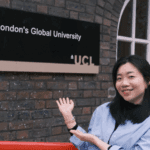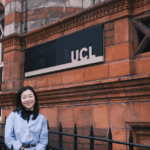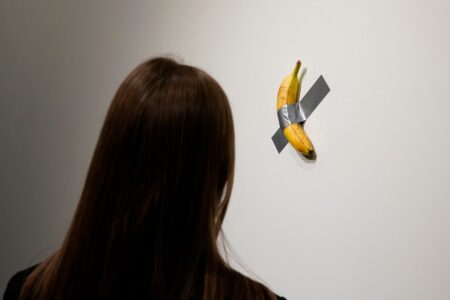
It’s not easy teaching art.
There’s the persistent narrative that art-related degrees aren’t as valuable as their STEM counterparts. The fact that the arts are the first to be forsaken when a financial crisis hits. Desperate students submitting what their programmes or lecturers demand of them instead of exploring their own creativity.
“It’s really hard to explain to students why they should continue studying arts and go where they want to go to do what they want to do,” says Sofia Vlazaki, an artist and academic tutor at the University of West Attica in Greece.
“But I have to tell them that you need like whatever you do. Because it’s going to be hard, so at least you have to work in something that you really love to make it more bearable this way.”

Vlazaki studied in the UK and earned her bachelor’s and three master’s degrees from the UK. Source: Sofia Vlazaki
One artist, four postgraduate degrees in art
Born and raised in Chania, a city on the northwest coast of the Greek island of Crete, Vlazaki would visit museums and historical sites with her archaeologist mother and watch her father paint Byzantine murals in churches.
“My mum wanted me to be a child as long as I could, so I had a really happy childhood being a child and not an adult,” says Vlazaki. “So my art is influenced by that – I’m very interested in the way children play in order to realise themselves, and I believe that it’s something artists have in common with children, using play to realise themselves, like a rehearsal for reality.”
Later on, her interest in art led her to pursue several degrees:
- a BFA in Painting at the University of Wales in Cardiff, UK
- an MFA in Drawing at Wimbledon College of Arts, University of the Arts, London
- an MA in Illustration: Authorial Practice at Falmouth University; and
- an MA in Book Arts at Camberwell College of Arts, University of the Arts London.

A page from the book “My Paths in Crete: Apokoronas.” Vlazaki’s illustration can be seen on the top left corner of the book. Source: Sofia Vlazaki
During that time, Vlazaki even earned the Ferdynand Sweig Travel Scholarship to research Book Arts in Tokyo, Japan.
Since then, Vlazaki has presented her work at conferences, solo and group shows, and books at home and abroad.
Recently, she created painted illustrations promoting the UNESCO sites in Crete – something Vlazaki takes much pride in.
Beyond that, Vlazaki has been a Drawing and Illustration academic tutor at the University of West Attica since 2005, and in recent years, joined the university’s Department of Graphic Design and Visual Communication as a PhD candidate in Book Arts.
It is here that Vlazaki has realised that teaching art goes beyond the literal sense – there’s more that needs to be done too.
View this post on Instagram
Changing the approach to teaching art, one student at a time
Vlazaki is well aware that her art career would’ve gone nowhere had her family not support her.
“If I didn’t have this base from my family, pushing me to do what I love and not pushing me to make money, I wouldn’t be able to do what I do now,” she says.
Unlike other fields, career opportunities for artists aren’t always bountiful.
“The first thing that stopped with the 2008 financial crisis was the art,” recalls Vlazaki. “Nobody was buying art; they were buying food, so we stopped getting money.”
Having personally experienced such uncertainty makes Vlazaki more determined to advise and guide her colleagues facing any similar hardship.

Vlazaki (middle), interviewing artist and author of “Big Panda & Tiny Dragon,” James Norbury (left) at the University of West Attica. Source: Sofia Vlazaki
Her own teachers have done the same.
“What helped me was when they were telling me not to change my work, but instead were pointing out aspects in my work that they couldn’t understand or relate to and wanted me to explain, in my own way, through drawing or painting,” shares Vlazaki.
Vlazaki recalls another instance fondly. During her drawing degree, a Chinese tutor had pointed out a line around her work, as though Vlazaki was suggesting the art to be something comic and stylised instead of something realistic, which was what she had been going for.
“She pointed to my hand and said ‘You don’t see a line here, but you can tell that it’s different,’” says Vlazaki. “In Greek, we say this is like coming down to you and focusing on what you’re doing. She could concentrate on my work and the details to tell me exactly what’s going on there and what she understands as an individual, and I think that helps very much, and it’s something that I try to do too.”

One of Vlazaki’s artworks, titled “Card Players.” Source: Sofia Vlazaki
But in a system that prioritises standardised academic results, Vlazaki has a long fight ahead of her in teaching art.
“Everyone teaches in their own manner, and there are some students who do what they are told to do because if they don’t follow the instructions, they are told that their work is not good or it’s awful,” shares Vlazaki. “So there is a big percentage of students who want to get a good mark and are willing to do whatever they’re told.”
It can take over a month to convince students otherwise, but Vlazaki isn’t deterred by it.
“I shape them to take their cases on their hands and not do what they’re told if they don’t like it,” she says. “I’m telling them that the marks are not important; what’s important is to do what you want to do and to learn from it.”

One of Vlazaki’s artworks, “Press,” was featured in a show at the Greek National Printing House in 2015, and will be featured in an upcoming group show, “Frontpage,” in May 2025 in Athens. Source: Sofia Vlazaki
The best part about teaching art and building your art career
It’s not all bad though – making and teaching art can be and has been fulfilling for Vlazaki.
Being able to play a part in guiding students in creating the best pieces of art they can to has been nothing short of rewarding, and it’s something Vlazaki hopes to do as long as she is able to.
The real happiness of being an artist, however, comes from simply being able to create art.
“When I sit down and do what I want to do, it’s like a dream,” laughs Vlazaki. “Studio work is the best for me because I can put some music on the side and do everything on my own pace. It’s idyllic.”










